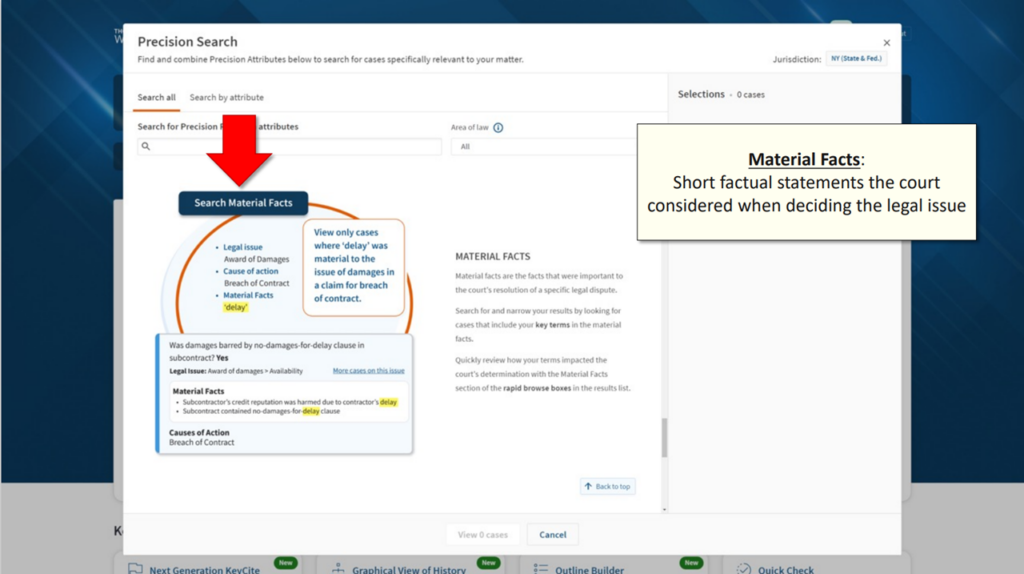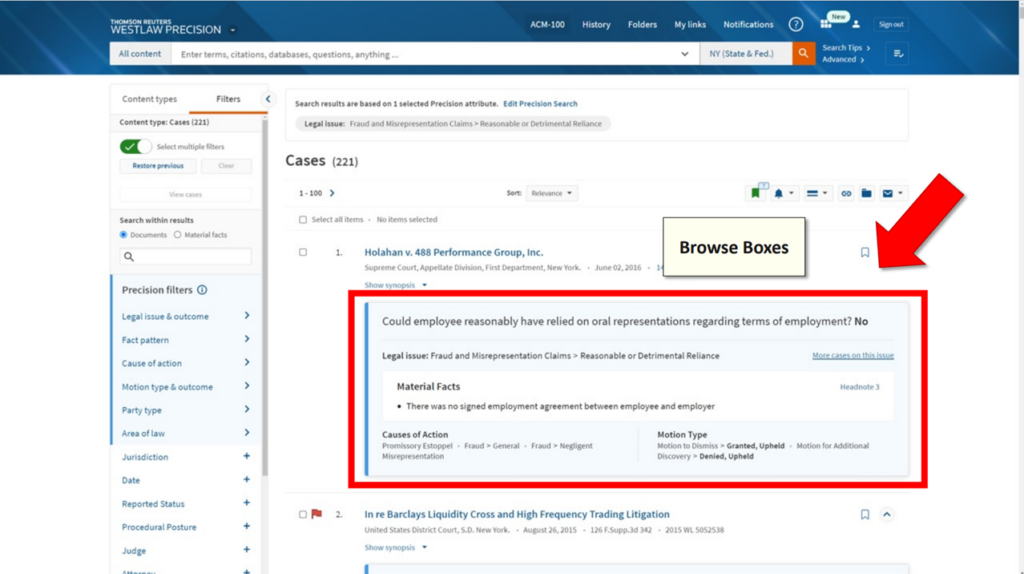After investing in 250 attorney editors who have undertaken around 18 months of tagging and categorisation of case law, Thomson Reuters today (14 September) unveiled a new version of Westlaw, which it says reduces research time by around half in many cases.
While Westlaw has long classified legal issues with the West Key Number System, Westlaw Precision, as the new version is called, also classifies cases by issue outcome, fact pattern, motion type, motion outcome, cause of action and party type. The editorial team is going through case law and tagging it going back 12 years. It has now completed eight topics and by the end of 2022 will have completed 15 more.
The new version will be available to customers as an upgrade, with customers paying a premium to access the new capabilities. A number of beta customers of Westlaw Precision have already signed up, including white shoe law firm Shearman & Sterling and litigation law firm Larson.
In a closely guarded ahead-of-release demonstration by head of research products and editorial, Andy Martens, and head of product management for Westlaw in the UK, US and Canada, Mike Dahn, the TR team talked about its transformation change programme over the last 12 months. Martens pointed out that TR has introduced Westlaw Edge in Canada and this year rolled out new contract lifecycle management capability and multiple new HighQ modules as well as Legal Tracker Advanced. “However, our strategic priority revolves around content-driven technology,” he told a group of legal journalists given advance sight of Westlaw Precision. “What we’re really talking about is that we continue to build on content and data analytics – all the things we see in Westlaw Edge and the PLC Dynamic Tool Set – and it’s about bringing content together with productivity software.”
In a demonstration by Dahn, he said that TR’s research showed that legal research on average takes 12 hours, with that jumping to 22.5 hours at large global law firms undertaking difficult cases. “Why does legal research take so long?” he asked. “Sometimes words come up but in the wrong context. We want to help lawyers identify exactly what they want, not just the same language.”


If you are looking for a liability waiver, many cases won’t use that phrase – maybe they will use liability limitation or waiver of damages – and Dahn said: “It’s easy to miss relevant cases. That’s why legal research experts will say no-one has a really good Boolean search. The language that judges use is too imprecise and it can be difficult to think of all the words.”
Similarly, lawyers are often looking for cases that match their clients procedurally and Dahn said: “If a lawyer was searching for case law where there was no breach and a motion to summary judgment and the motion was granted, they want the issue, the facts and the outcome. They want cases like my client’s at the same procedural posture.”
TR, Dahn said, has made the largest ever investment in editorial, hiring over 200 attorneys to its editorial staff and investing in the right editorial tools so they can tag cases with far more granularity than before.
“We have been tagging for well over a year with the West Key system, but this goes much further,” he said. “This is not the issue but the outcome. Was fraud found or was it not found? We are tagging material facts, the facts that are the most important to reach the decision that the judge makes. Was it pharma or consumer? We have tagged that now because it helps lawyers to find the situation that is most helpful. This was a case of a motion to dismiss and it was granted or denied, and we have tagged the cause of action.”
TR has also developed a new way of viewing the results in a question and answer format as well as the traditional highlighted hits view.
The company is rightly proud of the granularity of the new research capability and Dahn said: “We’ve not taken any functionality or content away, this has all the same functional content and AI as Edge but it includes new capability and more important is the precision research. You can specify the action type, party type, area of law and material facts. It’s not just about delivering goods but the type of goods, so you can say I only want cases involving butter or transistors. With the new functionality, you can be so much more precise.”
According to Dahn, in a research exercise tested on 101 attorneys, traditional research methods took 4.75 hours and found nine cases. With Precision, less cases were presented for consideration at the outset but 10 cases were found and the exercise took under two hours.
Other new functionality in Precision includes KeyCite Cited With – which shows which cases are most often cited with that case. KeyCite Today shows which bits of cases are no longer valid. Also new is Outline Builder, which pulls together citations and headings to build a piece of research, reducing the back and forth between Westlaw and Microsoft Word when doing research, which is particularly useful for attorneys that do not have two screens or are working away from the office. Keep List/Hide details enables users to save cases of interest and hide the ones that they have decided are not relevant to the current research.
“What Westlaw Precision does is it takes the critical quality information that Westlaw already brings to the table and elevates it to a new level,” said Meredith Williams-Range, chief knowledge and client value officer at Shearman. “One of the reasons we choose to continuously partner with Thomson Reuters and to be early adopters for the products that you bring to us is because you are changing the game that others are just not even coming to play in.”









